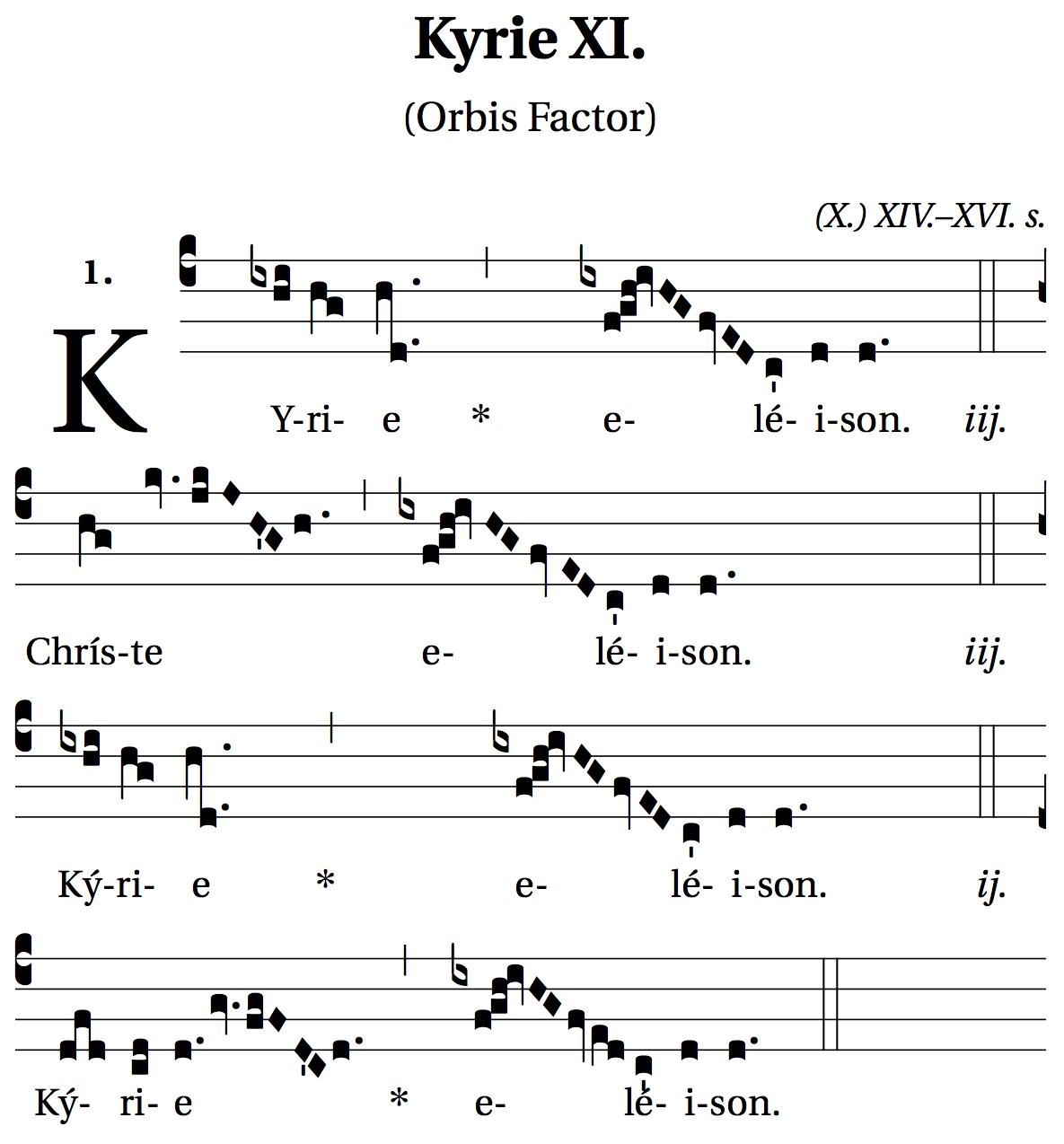
キリエ
☆
ギリシャ語の「Κύριε(キュリエ)=主」の転写である「Kyrie(キリエ)」は、キリスト教の典礼における重要な祈りの一般的な名称であり、
「Kyrie eleison(/ˈkɪri.eɪ ɛˈleɪ.isɒn/ KEER-ee-ay el-AY-eess-on; 古代ギリシャ語:
Κύριε ἐλέησον, romanized: 「主よ、憐れみを」という意味である。[1]
| Kyrie,
a transliteration of Greek Κύριε, vocative case of Κύριος (Kyrios), is
a common name of an important prayer of Christian liturgy, also called
the Kyrie eleison (/ˈkɪri.eɪ ɛˈleɪ.isɒn/ KEER-ee-ay el-AY-eess-on;
Ancient Greek: Κύριε ἐλέησον, romanized: Kýrie eléēson, lit. 'Lord have
mercy').[1] |
ギリシャ語の「Κύριε(キュリエ)=主」の転写である「Kyrie
(キリエ)」は、キリスト教の典礼における重要な祈りの一般的な名称であり、「Kyrie eleison(/ˈkɪri.eɪ
ɛˈleɪ.isɒn/ KEER-ee-ay el-AY-eess-on; 古代ギリシャ語: Κύριε ἐλέησον,
romanized: 「主よ、憐れみを」という意味である。[1] |
| In the Bible Further information: Chesed and Eleos The prayer, Kýrie, eléison, "Lord, have mercy" derives from a Biblical phrase. Greek ἐλέησόν με κύριε, 'have mercy on me, Lord', is the Septuagint translation of the phrase חָנֵּנִי יְהוָה often found in the Psalms (6:2, 9:13, 31:9, 86:3, and 123:3). In the New Testament, the Greek phrase occurs three times in Matthew: Matthew 15:22: the Canaanite woman cries out to Jesus, "Have mercy on me, O Lord, Son of David." (Ἐλέησόν με κύριε υἱὲ Δαβίδ) Matthew 17:15: "Lord, have mercy on my son" (Κύριε ἐλέησόν μου τὸν υἱόν) Matthew 20:30: two unnamed blind men call out to Jesus, "Lord, have mercy on us, Son of David." (Ἐλέησον ἡμᾶς κύριε υἱὸς Δαβίδ) In the Parable of the Publican and the Pharisee (Luke 18:9–14) the despised tax collector who cries out "Lord have mercy on me, a sinner" is contrasted with the smug Pharisee who believes he has no need for forgiveness. Luke 17:13 has epistates, 'master', instead of kyrios, 'lord', (Ἰησοῦ ἐπιστάτα ἐλέησον ἡμᾶς), being less suggestive of the kyrios 'lord' used as euphemism for YHWH in the Septuagint. There are other examples in the text of the gospels without the kyrie 'lord', e.g. Mark 10:46, where blind Bartimaeus cries out, "Jesus, Son of David, have mercy on me." In the biblical text, the phrase is always personalized by an explicit object (such as "on me", "on us", "on my son"),[2] while in the Eucharistic celebration it can be seen more as a general expression of confidence in God's love.[3]: 293 |
聖書では さらに詳しい情報: チェセドとエレオス 「主よ、憐れみを」という祈り「キリエ・エレイソン」は、聖書のフレーズに由来する。ギリシャ語の「ἐλέησόν με κύριε(主よ、憐れみを)」は、詩篇(6:2、9:13、31:9、86:3、123:3)に頻繁に登場する「חָנֵּנִי יְהוָה(主よ、憐れみを)」という句のセプトゥアギンタ訳である。 新約聖書では、このギリシャ語のフレーズはマタイによる福音書に3回登場する。 マタイによる福音書15:22:カナンの女がイエスに叫ぶ、「主よ、ダビデの子よ、私をあわれんでください」(Ἐλέησόν με κύριε υἱὲ Δαβίδ) マタイによる福音書17章15節:「主よ、私の子をあわれんでください」(Κύριε ἐλέησόν μου τὸν υἱόν) マタイによる福音書20章30節:名も記されていない盲目の二人の男がイエスに叫びかける。「主よ、私たちをあわれんでください。ダビデの子よ。」 (Ἐλέησον ἡμᾶς κύριε υἱὸς Δαβίδ) 取税人とパリサイ人のたとえ(ルカによる福音書18:9-14)では、軽蔑されていた取税人が「主よ、罪人の私を憐れんでください」と叫ぶ場面と、赦しな ど必要ないと思っている高慢なパリサイ人との対比が描かれている。 ルカによる福音書17章13節では、Kyrios(主)の代わりに「主人」を意味するepistates(Ἰησοῦ ἐπιστάτα ἐλέησον ἡμᾶς)が使用されており、これはセプトゥアギンタでYHWHの婉曲表現として使用されているKyrios(主)を暗示するものではない。 例えば、マルコによる福音書10章46節では、盲目のバルティマイが「ダビデの子イエスよ、私をあわれんでください」と叫んでいる。 聖書のテキストでは、このフレーズは常に明確な対象(「私に」「私たちに」「私の息子に」など)によって人格化されているが、[2] 聖餐式においては、神の愛に対する一般的な信頼の表現と見なされることが多い。[3]:293 |
| In Eastern Christianity See also: Hesychasm The phrase Kýrie, eléison (Ancient Greek: Κύριε, ἐλέησον), whether in Greek or in other languages, is one of the most oft-repeated phrases in Eastern Christianity, including the Eastern Orthodox, Oriental Orthodox, Assyrian Nestorian, and Eastern Catholic Churches. The Greek phrase, Kýrie, eléison, is for instance extensively used in the Coptic (Egyptian) Christian liturgy, which uses both the Coptic and the Greek languages. The various litanies, frequent in Eastern Orthodox rites, generally have Lord, have mercy as their response, either singly or triply. Some petitions in these litanies will have twelve or even forty repetitions of the phrase as a response. The phrase is also the origin of the Jesus Prayer, beloved by Eastern Christians as a foundation of personal prayer, and is increasingly popular among some Western Christians. The prayer is simultaneously a petition and a prayer of thanksgiving; an acknowledgement of what God has done, what God is doing, and what God will continue to do. It is refined in the Parable of the Pharisee and the Publican (Luke 18:9–14), where the Publican prays "God, have mercy on me, a sinner", thus showing more clearly its connection with the Jesus Prayer. |
東方キリスト教において 関連項目:ヘシカズム ギリシャ語であれ、その他の言語であれ、「主よ、憐れみたまえ」(ギリシャ語:Κύριε, ἐλέησον)というフレーズは、東方正教会、東方諸教会、アッシリア・ネストリウス派教会、東方カトリック教会を含む東方キリスト教において最も頻繁 に繰り返されるフレーズのひとつである。ギリシャ語の「キリエ・エレイソン」というフレーズは、コプト語(エジプト語)とギリシャ語の両方を使用するコプ ト教会(エジプト教会)のキリスト教典礼でも広く使用されている。 東方正教会の儀式で頻繁に用いられるさまざまな連祷では、通常「主よ、憐れみたまえ」という言葉が単独または3回繰り返される。これらの連祷の一部の祈願 では、このフレーズが12回または40回繰り返されることもある。 このフレーズは、東方キリスト教徒に愛され、個人の祈りの基礎として用いられている「イエス・プレイヤー」の起源でもある。また、この祈りは、一部の西洋 キリスト教徒の間でも人気が高まっている。 この祈りは、同時に嘆願であり、感謝の祈りでもある。神が成し遂げられたこと、神が今なさっていること、そして神がこれからもなさるであろうことを認める ことである。この祈りは、パリサイ人と収税人のたとえ話(ルカによる福音書18:9-14)の中で洗練されている。収税人は「神様、罪人の私を憐れんでく ださい」と祈り、イエス・キリストの祈りとのつながりをより明確に示している。 |
| In Western Christianity In Rome, the liturgy was first celebrated in Greek. Josef Jungmann suggests the Kyrie in the Roman Mass is best seen as a vestige of an opening litany like those in some Eastern churches, which was retained even after Latin became normative.[3]: 335f. As early as the sixth century, Pope Gregory the Great noted that there were differences in the way in which Eastern and Western churches sang the Kyrie. In the Eastern churches it is sung in unison by those present, whereas in the Western church the clergy sing and the people respond. Also, the Western church would sing Christe, eléison as many times as Kýrie, eléison.[1][4] In the Roman Rite liturgy, the variant Christe, eléison, is a transliteration of Greek, Χριστέ, ἐλέησον. Kýrie, eléison may also be used as a response of the people to intentions mentioned in the Prayer of the Faithful. Since 1549, Anglicans have normally sung or said the Kyrie in English. In the 1552 Book of Common Prayer, the Kyrie was inserted into a recitation of the Ten Commandments. Modern revisions of the Prayer Book have restored the option of saying the Kyrie without the Commandments. Other denominations, such as Lutheranism and Methodism, also use the Kyrie in their respective liturgies.[5] |
西方キリスト教 ローマでは、典礼はまずギリシャ語で祝われた。ヨゼフ・ユングマンは、ローマ・ミサにおけるキリエは、いくつかの東方教会に見られるような開祭の連祷の名 残であり、ラテン語が標準語となった後も残ったものだと考えられると示唆している。[3]:335f. 早くも6世紀には、教皇グレゴリウス1世は、東方教会と西方教会のキリエの歌い方に違いがあることに気づいていた。東方教会では、その場にいる人々によっ てユニゾンで歌われるが、西方教会では聖職者が歌い、人々はそれに答える。また、西方教会では、キリエ・エレイソンと同じ回数だけクリステ・エレイソンが 歌われる。[1][4]ローマ典礼では、クリステ・エレイソンという異形のものは、ギリシャ語のΧριστέ, ἐλέησονの転写である。 キリエ・エレイソンは、信仰者の祈りの中で述べられた意図に対する人々の応答としても用いられる。1549年以降、聖公会では通常、キリエを英語で歌った り、口ずさんだりしている。1552年の『共通の祈りの書』では、キリエが十戒の朗読に挿入された。現代の『共通の祈りの書』の改訂版では、戒律なしにキ リエを口ずさむという選択肢が復活している。ルーテル派やメソジスト派などの他の宗派でも、それぞれの典礼でキリエが使用されている。[5] |
| Kyrie as section of the Mass
ordinary See also: Mass ordinary § I. Kyrie In the Tridentine Mass form of the Roman Rite, Kýrie, eléison is sung or said three times, followed by a threefold Christe, eléison and by another threefold Kýrie, eléison. Collectively, the nine invocations are said to unite the petitions of the faithful to those of the nine choirs of angels in heaven. Text Kýrie, eléison (Κύριε, ἐλέησον) 'Lord, have mercy' Christe, eléison (Χριστέ, ἐλέησον) 'Christ, have mercy' Musical settings Further information: Mass (music) § I. Kyrie The Kyrie is the first sung prayer of the Mass ordinary and is usually part of any musical setting of the Mass, one exception being the early English school, whose liturgy featured a troped Kyrie that was therefore proper to the day. Kyrie movements sometimes have a ternary (ABA) musical structure that reflects the symmetrical structure of the text. Polyphonic settings can be found in five (or four) movements, calling for alternatim performance, i. e. alternating with Gregorian chant or with organ versets. Musical settings exist in a variety of styles. In litanies Reflecting its original liturgical function, the Kyrie is the standard beginning for public and private litanies in the Roman Rite, such as the Litany of the Saints or the Litany of the Blessed Virgin Mary.[6] |
ミサの通常唱におけるキリエ 参照:ミサ通常唱 § I. キリエ ローマ典礼のトリエント・ミサ形式では、キリエ・エレイソンは3回歌われるか唱えられ、続いて3回繰り返されるクリステ・エレイソン、さらに3回繰り返さ れるキリエ・エレイソンが続く。 これら9回の呼びかけは、信者の祈りを天上の9つの天使の合唱団の祈りと結びつけるとされる。 テキスト キリエ・エレイソン(Κύριε, ἐλέησον) 「主よ、憐れみたまえ」 クリステ・エレイソン(Χριστέ, ἐλέησον) 「キリストよ、憐れみたまえ」 音楽設定 詳細情報:ミサ曲 § I. キリエ キリエはミサ曲の最初の祈りで、通常はミサの音楽設定の一部である。例外は初期のイングランド楽派で、典礼ではトロペのキリエが採用されていたため、それ はその日にふさわしいものとなった。キリエの楽章は、テキストの対称的な構造を反映した三部分(ABA)の音楽構造を持つことがある。多声部の設定は5つ の(または4つの)楽章で見られ、グレゴリオ聖歌やオルガンの間奏曲と交互に演奏される。音楽の設定はさまざまなスタイルで存在する。 連祷では その本来の典礼上の機能が反映されているように、キリエは、ローマ典礼における公的および私的な連祷の標準的な始まりであり、聖人連祷や聖母マリア連祷な どがある。[6] |
| Modern Catholic thought The terms aggiornamento (bringing up to date) and ressourcement (light of the Gospel) figure significantly into the documents of Vatican II: “The Church carries the responsibility of scrutinizing the signs of the times and interpreting them in the light of the Gospel” (Gaudium et spes, 4).[7] Louis Bouyer, a theologian at Vatican II, claimed that there was a distortion of the Eucharistic spirit of the Mass over the centuries, so that "one could find merely traces of the original sense of the Eucharist as a thanksgiving for the wonders God has wrought.”[8] The General Instruction of the Roman Missal (GIRM) notes that at the Council of Trent "manuscripts in the Vatican ... by no means made it possible to inquire into 'ancient and approved authors' farther back than the liturgical commentaries of the Middle Ages ... [But] traditions dating back to the first centuries, before the formation of the rites of East and West, are better known today because of the discovery of so many liturgical documents" (7f.). Consonant with these modern studies, theologians have suggested that there be a continuity in praise of God between the opening song and the praise of the Gloria. This is explained by Mark R. Francis of Catholic Theological Union in Chicago, speaking of the Kyrie: Its emphasis is not on us (our sinfulness) but on God’s mercy and salvific action in Jesus Christ. It could just as accurately be translated "O Lord, you are merciful!" Note that the sample tropes all mention what Christ has done for us, not how we have sinned. For example, “you were sent to heal the contrite,” “you have shown us the way to the Father,” or “you come in word and sacrament to strengthen us in holiness,” leading to further acclamation of God’s praises in the Gloria.[9] In this same line, Hans Urs von Balthasar calls for a renewal of the focus at the Eucharist: We must make every effort to arouse the sense of community within the liturgy, to restore liturgy to the ecclesial plane, where individuals can take their proper place in it…. Liturgical piety involves a total turning from concern with one’s inner state to the attitude and feeling of the Church. It means enlarging the scope of prayer, so often narrow and selfish, to embrace the concerns of the whole Church and, indeed – as in the Our Father – of God.”[10] In the New Dictionary of Sacramental Worship, the need to establish communion is reinforced as it quotes the GIRM to the effect that the purpose of the introductory rites is “to ensure that the faithful who come together as one establish communion and dispose themselves to listen properly to God's word and to celebrate the Eucharist worthily” (GIRM, 46, emphasis added).[11] |
現代のカトリック思想 アッジョルナメンテ(現代化)とレゾルスメ(福音の光)という用語は、バチカン2世の文書に頻繁に登場する。「教会は、時代の兆候を注意深く観察し、福音 の光に照らして解釈する責任を担っている」(『喜びと希望』4)。[7] 第二バチカン公会議の神学者ルイ・ブイエは、ミサの聖体精神が何世紀にもわたってゆがめられてきたと主張し、「神が成し遂げられた奇跡に対する感謝として の聖体の本来の意味は、その痕跡をわずかに見つけることができるだけだ」と述べている。 [8] 『ローマ・ミサ典礼書総解説』(GIRM)は、トレント公会議において、「バチカンにある写本は... 中世の典礼解説書よりもさらに遡って『古代の信頼できる著者』を調査することを決して可能にするものではなかった... しかし、東西の儀式が形成される前の最初の世紀にまで遡る伝統は、数多くの典礼文書が発見されたことにより、今日ではより良く知られている」(7f.)。 これらの近代的研究と一致して、神学者たちは、冒頭の歌とグローリアの賛美の間には神への賛美の連続性があることを示唆している。これは、シカゴのカト リック神学連合のマーク・R・フランシスがキリエについて語った内容で説明されている。 その強調点は私たち(私たちの罪深さ)ではなく、神の慈しみとイエス・キリストにおける救済的な行動にある。「主よ、あなたは慈しみ深い!」と訳しても まったく同じ意味である。サンプルの定型句はすべて、キリストが私たちのためにしてくださったことについて述べているが、私たちがどのように罪を犯したか については述べていないことに注目すべきである。例えば、「あなたは悔い改める者を癒すために遣わされた」、「あなたは私たちに父なる神への道を示され た」、「あなたはみことばと聖餐によって私たちを聖性において強めてくださる」などであり、これらはグローリアにおける神への賛美をさらに高めることにな る。[9] この同じ流れの中で、ハンス・ウルス・フォン・バルタザールは、聖体における焦点の刷新を呼びかけている。 私たちは、典礼の中で共同体としての感覚を呼び覚ますためにあらゆる努力をしなければならない。また、典礼を教会の場に回復し、個人がその場において適切 な位置を占めることができるようにしなければならない。典礼上の敬虔さとは、自分の内面への関心から、教会の態度や感情へと完全に方向転換することであ る。それは、狭量で利己的な祈りの範囲を広げ、教会全体の関心ごとを受け入れることを意味する。実際、それは「私たちの父」のように、神の関心ごとを受け 入れることでもある。 『聖礼典の新しい辞典』では、導入の儀式の目的は「一つになって集まる信者が交わりを確立し、神の言葉を正しく聞き、ふさわしく聖体拝領を行うよう整える こと」であるという『GIRM』の趣旨を引用し、交わりを確立する必要性が強調されている(『GIRM』46、強調付加)[11]。 |
| Jesus Prayer Kyriacos List of Greek phrases |
ジーザス・プレイヤー キリアコス ギリシャ語のフレーズ一覧 |
| General and cited references Hoppin, Richard. Medieval Music. New York: W. W. Norton and Co., 1978. ISBN 0-393-09090-6. pp. 133–134 (Gregorian chants), 150 (tropes). |
一般および引用文献 ホッピン、リチャード著『中世音楽』ニューヨーク:W. W. Norton and Co.、1978年。ISBN 0-393-09090-6。133~134ページ(グレゴリオ聖歌)、150ページ(転回)。 |
| https://en.wikipedia.org/wiki/Kyrie |
|
Kyrie
XI ("orbis factor")—a fairly ornamented setting of the Kyrie in
Gregorian chant—from the Liber Usualis
リ ンク
文 献
そ の他の情報
Copyleft, CC, Mitzub'ixi Quq Chi'j, 1996-2099
☆
 ☆
☆